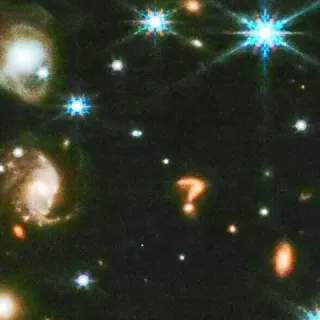In a stunning revelation that has ignited the curiosity of astronomers and space enthusiasts alike, the James Webb Space Telescope (JWST) has unveiled a captivating image that appears to depict two of our galaxy's well-known stars, Herbig-Haro 46/47, photobombed by an enigmatic celestial question mark. This captivating occurrence, captured by the JWST's NIRCam instrument using infrared light, has opened a window into the intricate world of star formation while offering a tantalizing glimpse of a distant cosmic collision.
Located a mere 1,400 light-years away, Herbig-Haro 46/47 has long been a subject of fascination for scientists due to its potential to illuminate the intricate processes that led to the birth of our very own sun. These young stars, still in their gestational phase and yet to blaze into the brilliance of their own nuclear fusion, are considered celestial time capsules that may offer invaluable insights into the earliest stages of stellar evolution.
What sets this new image apart is not only its stunning clarity, a testament to the groundbreaking capabilities of the JWST, but also the celestial question mark that takes center stage, seemingly out of place amidst the cosmic ballet of star formation. The JWST's advanced infrared technology allowed this peculiar object to emerge from the shroud of space dust that often obscures such phenomena from visible light observations.
Christopher Britt, an education and outreach scientist at the Space Telescope Science Institute and a key figure in planning these observations, ventures a daring hypothesis about the origin of this distant question mark. While the stars Herbig-Haro 46/47 are relatively close neighbors in galactic terms, this celestial punctuation mark resides billions of light-years away, far beyond our immediate galactic neighborhood. Britt suggests that this anomaly might not be a singular entity but a grand cosmic event: the merging of two galaxies.
The notion of galaxies merging is a concept both captivating and profound. Galaxies, vast systems of stars, gas, and cosmic matter, occasionally engage in gravitational dances that bring them together over cosmic timescales. As galaxies intertwine, their structures morph, stars are born anew, and the very fabric of the universe seems to rewrite itself. If Britt's conjecture proves accurate, this photobombing question mark could be a visual echo of a collision between distant galaxies, an event that occurred eons ago but whose light has only now reached our telescopic lenses.
The implications of such a discovery extend beyond the mere intersection of chance and cosmic wonder. The merger of galaxies is a cosmic crucible where the most extreme forces of nature play out. Gravitational tugs reshape galaxies, triggering the birth of stars as interstellar gases collide and collapse. Black holes at galactic cores engage in a deadly waltz, emitting powerful jets of energy as they consume matter. Such collisions are laboratories for understanding the very nature of the universe, where fundamental questions about the distribution of matter, the nature of space-time, and the destiny of galaxies are put to the ultimate test.
As astronomers continue to unravel the secrets held within this captivating image, the cosmic question mark remains a symbol of exploration and curiosity. It is a testament to the capacity of human ingenuity to unveil the enigmas of the universe, one pixel at a time. With the JWST's impressive capabilities, we are reminded that even stars in their infancy, like Herbig-Haro 46/47, are part of a broader cosmic tapestry that extends beyond our own galaxy. As we gaze at this captivating image, we are invited to ponder the mysteries of creation, the forces that shape our cosmos, and the inexhaustible wonders that await our discovery in the celestial realms.




.jpg)
What do you think about this?